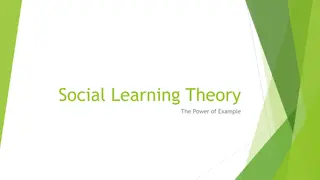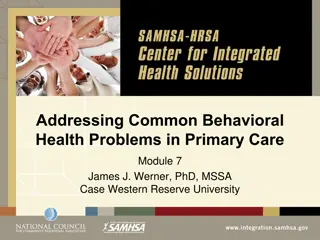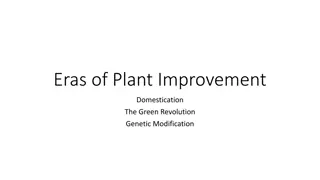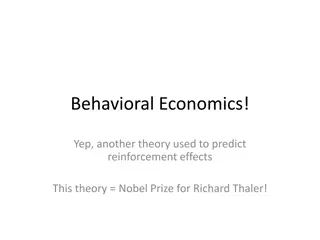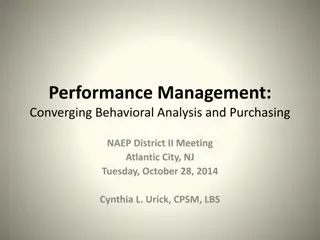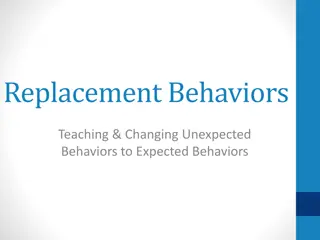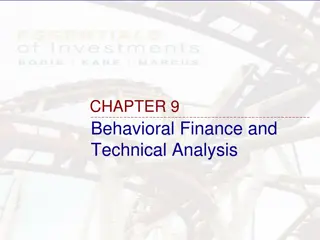Understanding Principles of Learning Theory and Behavioral Modification
Explore the principles of learning theory and its application in behavioral modification, highlighting concepts such as classical and operant conditioning. Learning, defined as a permanent change in behavior due to experience, is distinguished from performance. Discover how learning potential differs from actual behavior and the significance of applying learning theory in behavioral interventions.
- Learning theory
- Behavioral modification
- Classical conditioning
- Operant conditioning
- Behavioral interventions
Download Presentation

Please find below an Image/Link to download the presentation.
The content on the website is provided AS IS for your information and personal use only. It may not be sold, licensed, or shared on other websites without obtaining consent from the author. Download presentation by click this link. If you encounter any issues during the download, it is possible that the publisher has removed the file from their server.
E N D
Presentation Transcript
PRINCIPLES OF LEARNING THEORY & APPLICATION TO BEHAVIOURAL MODIFICATION By Dr. Edebor, Ehiremen Davidson Federal Neuro-psychiatric Hospital, Benin. 14th September 2022 1
OUTLINE Objectives Introduction Learning Theory Application of Learning Theory to Behavioural Modification Conclusion References 2
Objectives To understand the principles of Learning theory. To know the applications of Learning theory in Behaviour Modification 3
Introduction The concept of learning is a good example of the discrepancy between the everyday, common-sense use of a term and its technical, scientific use. Learning is a hypothetical construct: it cannot be observed directly; instead, it can only be inferred from observable behaviour. 4
Definition of Learning Learning can be defined as a relatively permanent change in behaviour due to past experience (Coon, 1983). Learning can also be defined as the process by which relatively permanent changes occur in behavioural potential as a result of experience (Anderson, 1995). 5
Learning vs Performance The 2nd definition has one major advantage over the 1st; namely, it implies a distinction between learning (behavioural potential) & performance (actual behaviour). So what one could do (potential behaviour based on learning) and what one is actually doing (current performance) are two different things. 6
Learning vs Performance contd Ultimately, the only proof of learning is a particular kind of performance (e.g. exams). Performance can fluctuate due to fatigue, use of drugs and emotional factors, and so it is much more variable than learning, which is more permanent. Many students have left an exam knowing what they could not demonstrate during the exam itself. 7
Learning Theory Classical Conditioning (CC) Operant Conditioning (OC) NB: Classical & operant conditioning are often referred to collectively as learning theory (behaviourist approach), as opposed to 'theories of learning', which usually imply theories other than conditioning theories (i.e non-behaviourist theories) 8
Classical Conditioning Described by Ivan Pavlov (1849 1936) in 1927, who trained dogs to salivate in response to a light or bell by associating it with food. Ivan Pavlov was a physiologist interested in the process of digestion in dogs. He was awarded the Nobel Prize in 1904 (the year Skinner was born). 9
Classical Conditioning contd He developed a surgical technique for collecting a dog s salivary secretions. A tube was attached to the outside of its cheek, so the drops of saliva could be measured easily. In addition, Ivan Pavlov also emphasized the importance of careful observation and serendipity in science. 10
Further Examples of Pairing the UCS & CS Simultaneous Conditioning Forward Conditioning: (a) Delay Conditioning (b) Trace Conditioning Backward Conditioning Higher Order Conditioning NB: Pavlov found with dogs that learning could not go beyond 3rd- or 4th-order conditioning. 12
Classical Conditioning Principles Acquisition stage: The period of pairing required between an Unconditioned Stimulus (UCS) and a Conditioned Stimulus (CS) for the association to be learned and the Conditioned Response (CR) to occur. Stimulus preparedness: This is the fact that certain stimuli are more likely to become a CS than others. 13
Classical Conditioning Principles contd Generalization: The CR transfers spontaneously to stimuli similar to, but different from, the original CS. Discrimination: This is the ability to recognize and respond to the differences between similar stimuli and can be produced by differential reinforcement. 14
Experimental Neurosis contd It was as if the dogs did not know how to respond: Was the stimulus a circle (in which case, through generalization, they ought to salivate), or Was it an ellipse (in which case, through discrimination, they should not salivate)? 16
Classical Conditioning Principles contd Extinction: This happens if the CS is repeatedly presented without the UCS then the CR gradually disappears, though usually not completely. Incubation: This refers to an increase in association between the CS and UCS despite disappearance of the UCS. This contrasts with extinction. 17
Classical Conditioning Principles contd Stimulus Recovery: This refers to the process whereby presentation of the CS after extinction will suddenly elicit a previous learned response, in this case salivation. This shows that extinction involves not an erasing of the original learning but rather a learning to inhibit or suppress the CR when the CS is continually presented without a UCS. 18
Operant Conditioning Skinner (1904 1990) proposed an associative learning theory based on Thorndike s (1874 1949) law of effect. This states that if a voluntary behaviour (operating on trial and error) is rewarded it will be repeated, and vice versa. Premack's Principle(Grandma's rule): The desired event is a reinforcer. Shaping: Rewarding closer & closer approximations of the wanted behavior until the correct behavior is achieved. 19
Operant Conditioning contd A hungry rat placed in a Skinner box (contains a lever which releases food pellets) learns to press the lever in order to receive food. In this way the CR (pressing the lever) is reinforced. Operant conditioning is thus an active form of learning (the rat must act in order for conditioning to occur). 20
Operant Conditioning Principles Reinforcement: Defined as a consequence which results in the subject increasing their behaviour. Reinforcement can be positive or negative but behaviour is always increased. 21
Operant Conditioning Principles contd Positive Reinforcement occurs when a reward reinforces a response and increases the likelihood of its occurrence. Negative Reinforcement occurs when something unpleasant or uncomfortable is removed or taken away in order to increase the likelihood of the desired behaviour. 22
Types of Reinforcers Primary reinforcers are stimuli that innately reinforce a behaviour and produce a desired response. Examples include food and warmth, i.e. the individual recognises this as an obvious reward and does not need to be conditioned to do so. 23
Types of Reinforcers contd Secondary reinforcers are stimuli that are associated with primary reinforcers. E.g money. Secondary reinforcers are associated with primary reinforcers through classical conditioning. An individual associates money with being able to buy food and warmth. 24
Reinforcement Schedules Continuous Reinforcement Schedules: Reinforces target behaviour every single time it occurs. More likely to result in extinction. Intermittent Reinforcement Schedules: Extinction is less likely There are different forms of intermittent schedules - ratio or interval - and these can be fixed or variable. 25
Intermittent Reinforcement Schedules Ratio refers to the number of responses required before a reinforcer is produced. In fixed ratio schedules, a fixed predetermined number of responses are reinforced. In variable ratio schedules, any response can be reinforced. E.g Gambling 26
Intermittent Reinforcement Schedules contd Interval refers to the time interval that needs to elapse before a reinforcer is produced. In fixed interval schedules, each time a certain time period elapses a reinforcer is produced. In variable interval schedules, the reinforcement occurs at any given time. 27
Intermittent Reinforcement Schedules cont'd Continuous reinforcement schedules allow for the quickest learning & fastest extinction. Learning is slowest with a variable interval schedule. Extinction is fastest with fixed ratio schedules. Variable ratio schedules are most resistant to extinction. 28
Punishment Punishment is an aversive consequence that is intended to reduce the likelihood of recurrence of undesired behaviour, and is most effective when given promptly. The removal of a punitive measure may allow it to act as a negative reinforcer. 29
Punishment cont'd Positive punishment: Describes adding an unpleasant stimulus after an undesired behaviour. Negative punishment: Describes removing a pleasant stimulus after an undesired behaviour. 30
Other Forms of Conditioning Escape conditioning is a form of operant conditioning whereby an individual engages in a particular behaviour to terminate an aversive stimulus. Avoidance conditioning is a form of operant conditioning whereby an individual prevents the unpleasant stimulus in the first place. 31
Behaviour Modification Refers to techniques used to try & decrease or increase a particular type of behaviour or reaction. Relies on the concept of conditioning (classical & operant). Just as behaviours can be learned, they can also be unlearned. 32
Techniques of Behaviour Modification Positive Reinforcement Negative Reinforcement Token Economy Punishment Chaining Covert Sensitization Overt Sensitization Enuretic alarm therapy 33
Positive Reinforcement In Child & Adolescent Psychiatry: Rewarding socially appropriate behaviour in children with disorders of intellectual development, ADHD and schizoid personality disorder. 34
Negative Reinforcement In Education: The same young girl has a gold star removed for every homework she fails to complete. The girl knows to avoid having stars deducted she needs to complete her homework. The removal of the aversive stimulus (in this case stars deducted) serves as the reinforcer to increase the desired behaviour of completing the homework. 35
Token Economy Common example of Operant conditioning techniques. Developed by Ayllon & Nazrin in 1961. This is often used used in behavioural management programmes for children, in which a desired behaviour is rewarded with stickers or tokens which can then be swapped for privileges. 36
Punishment Unlike reinforcement which is used to increase a desired behaviour, punishment is used to reduce an undesired behaviour. Using the same schooling example as above: At times, this young girl can spend hours doing her make-up in class rather than doing her work. 37
Punishment contd The teacher continually gives her F grades and puts her in detention. The F grades and detention serve as a 'punishment' which reduces the undesired behaviour of applying make-up. 38
Chaining Describes a series of stages that when completed in sequence result in an individual learning a complex task which would otherwise be difficult to learn. An example could be teaching a young child to write his/her name. 39
Chaining contd If the child's name is Sophie, first she learns that her name starts with the letter 'S'. When this stage is learnt & reinforced, she moves on to the letter 'O' and so on until the task is complete. 40
Covert Sensitization Based on the principle that by imagining an unpleasant stimulus the individual is able to modify their behaviour. Example: a previously poorly controlled diabetic imagines the long-term complications of their condition every time they are tempted by a sugary treat. 41
Overt Sensitization The opposite of Covert sensitization. Rather than imagining unpleasant stimuli, the individual is made to experience the unpleasant stimuli for themselves. Example: use of disulfiram in the treatment of alcohol abuse. When an individual ingests alcohol while on disulfiram, this results in unpleasant side effects which serve as the Aversive stimulus. 42
Conclusion Learning has played a major part in the development of psychology as a scientific discipline and is central to the behaviourist approach. Psychologists are interested in learning as a process. Learning theory is important in behavioural modification. 45
References Coon D (1983) Introduction to Psychology, 3rd edn. St Paul, MN: West Publishing Co. Anderson JR (1995) Learning and Memory: An Integrated Approach. Chichester: John Wiley & Sons. Puri, B., & Treasaden, I. (2009). Psychiatry: An evidence-based text. CRC press. 46
References contd Malhi, S., & Malhi, G. (2005). Examination Notes in Psychiatry-Basic Sciences 2Ed. CRC Press. Sarah, J. (2022). Revision Notes for MRCPsych Paper 1. CRC Press. Vijayalakshmi, N. (2019). Behavior Modification Techniques-An Awareness Study. Shanlax International Journal of Education, 7(2), 20-24. 47
THANK YOU!!! 48



